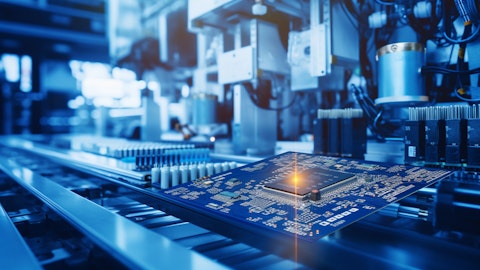Vincent Roche : Yeah. On the customer side of things, we’ve been monitoring very, very carefully across the various segments. Our customer shipment rates, their inventories and their ADI goods on hand. And we’re clearly under-shipping our customers’ current demands. So we feel that we’ve got a situation now in terms of our — we’re in a good inventory position on hand. Our customers are beginning, as Mike indicated, to replenish their order books, ADI’s goods. And that gives us the confidence as the book-to-bill approaches unity that we’re seeing the worst of the inventory correction. And in the second half, we will get back to a more normalized growth pattern. So as Mike said, there’s a very good balance between the direct channel, the distribution channel in terms of the inventory situation, but we’re ready for the upsurge.
Toshiya Hari : Great. Thank you.
Operator: Thank you. One moment for questions. Our next question comes from William Stein with Truist Securities. You may proceed.
William Stein : Great. Thanks for taking my questions. I want to welcome, Rich, but direct a couple of questions to Vince, please. Vince, the more vertical capabilities that you talked about, it sort of suggests that you’re needing to either partner more closely with a smaller number of customers or maybe you wind up pushing somewhat into their capabilities and are potentially competing with some of them. And I wonder how you contemplate managing that dynamic?
Vincent Roche : Yeah. Will, thanks very much. You’re — unfortunately, the line shopped. I think I got your question about verticalization, competing with our customers potentially. Hopefully, you can hear me, okay, that it’s not a two-way line problem here. Will, look, the — we’ve been on a journey over many, many years now to continue to build out our core component franchise, but also add more value to our solutions. Our business has become more solutions-oriented particularly over the last decade in every single segment that we play. And that kind of domain application-driven engineering that ADI has been distinguishing it so at the edge over the last decade, that will continue, and we’re continuing to build that. I talked on the — in the prepared remarks about this point of care, acute health care solution that we’ve just brought to market where we’ve got an FDA approval.
I think what’s happening, Will, in the world is that there are certain places like that where we have a white space to attack. We’re building a complete solution that has both hardware and software makes a lot of sense. But the truth is, even in the traditional markets and with the larger customers that we deal with, more and more footprint capture, if you like, has been taking place. Why? Because we tame our customers’ complexity. And I’ve talked before about the asymmetry and capabilities in the Analog space between the capabilities ADI has got and our customers have got. They expect us actually to add more solution value and build more complete solutions and clearly define where the line is between where their core value is versus where ADI’s core values.
So I think we’re not competing with our customers, but we have very vibrant discussions about where we draw the line of the labor divide, so to speak.
William Stein : That helps. If I can ask a follow-up. You talked a bit about AI. It’s sort of a familiar topic to us lately. Maybe too much so.
Vincent Roche : Not much.
William Stein : There’s a narrative here where there are some creative capabilities, in fact, I would say, engineering-focused capabilities that maybe made more efficient or productive with Generative AI. In a world where the story about Analog design engineer capability being so limited and that driving a significant advantage for ADI. I wonder if that story changes at all because of this capability. Have you started using this for circuit design? Or do you anticipate that it could be used by others, either competitors or customers? Thank you.
Vincent Roche : Yeah, it’s a good question. Well, look, everybody is trying to figure out the meaning of the AI in their businesses. We’re using AI today in our tool chains. We’re using machine learning and AI in our products, around our products. We’re starting to use it in our business. And I think — I believe that anything that can be — anything that is routine — and that can be automated, that’s the way of technology. Technology automation will take over the things that are more routine. We play very much at the high end of the performance spectrum. So unless there’s generative intelligence that can outperform our imaginations, which I don’t see any time in the foreseeable future. We’re truly in a realm where the intellectual property value and the learning system that we’ve got in this company will matter more and more.
But yeah, I think we view AI as a tremendous opportunity. As clearly in the product development process from how the products are designed, what we put as ingredients in our products, and we’re also, by the way, putting AI into the customer support tool chain. So it is a part. We’re embracing it, and we believe that it will be an accelerator and the copilot, if you like, with our engineering population.
William Stein : Thank you.
Michael Lucarelli : Thanks, Will, it sounds like from your cell phone line, we do need some more 5G coverage. So next question, please?
Operator: Thank you. One moment for questions. Our next question comes from Timothy Arcuri with UBS. You may proceed.
Timothy Arcuri : Hi, thanks a lot. Can you talk to any period costs versus underutilization charges that you’re taking? And any of those — how much of a headwind are those now? And how much will those help you as they might reverse themselves coming out of the downturn? Thanks.
Michael Lucarelli : So I think your question is on how much of the impact on our gross margins underutilization versus mix. I think if you look here, our peak gross margins were about 74%. Our outlook, as Rich pointed out, embeds about 67%. That decline is really mix and utilization, about equal parts, I’ll call it. As you look to the back half of this year, it depends what mix is going to do. I think industrial is bottoming here, so that should help a little bit. From a utilization standpoint, Rich also pointed out, our starts are low enough to reduce inventory meaningfully. We’ve been doing that. We’ll do it again in 2Q. So I don’t see it starts going down, they’re probably start going up, which should provide a tailwind to gross margins. How fast the gross margins pick up really depends on those 2 factors, how fast the revenue picks up and how much of it relates to the industrial sector.
Timothy Arcuri : Okay, Mike. But I guess, are there any inventory charges? That’s the question.
Michael Lucarelli : So from inventories, yeah, I would say, a good question. You’re right. We have a lot of inventory. As you can see on our balance sheet. The — there’s no acceleration of inventory charges in our gross margins. The inventory charge from a reserve standpoint have been elevated for the past few quarters, and they probably stay that way as you go into the back half of this year into next year. But that’s not a headwind anymore. It’s already kind of built in the run rate.
Timothy Arcuri : Okay, awesome. Thanks, Mike.
Michael Lucarelli : We will go to our last question, please.
Operator: One moment for our last question. And our last question comes from C.J. Muse with Cantor Fitzgerald. You may proceed.
CJ Muse: Yeah. Thank you for taking the question. You talked about auto being down sequentially, but seeing, I guess, the best performance out of all the different segments. Curious if you can kind of walk through what you’re seeing from Tier 1 auto correction and whether you think that will be completed exiting April as well? Thanks so much.
Michael Lucarelli : Yeah. Sure. From the auto standpoint, C.J., I would say, yes, there is definitely an inventory correction going on in auto like or market as Vince pointed that out, the supply fracture at everyone is, to a lesser degree, than auto than other markets, but it’s not really because of the inventory. It’s because of the growth drivers in that business, whether it’s BMS, GMSL AB functional safe power, the growth in those areas are offsetting the overall call it inventory digestion in automotive area. You’re right to say that on the Tier 1 side or the OEM side, there’s some froth inventory. But we’re seeing that being digested. Will it be all complete? By the second quarter, we’ll see, but I do feel good about those growth areas continue to grow this year.
And for the full year, will auto grow, I don’t know. We’ll see. But it really depends on how strong the growth is in the growth areas and how much of the overhang on the inventory side is. But net-net, we do feel good about auto being our best performing end market here in 2Q and for the full year ’24.
Vincent Roche : All right. Thank you, CJ. Thanks, everyone, for joining our call this morning. A copy of the transcript will be available on the website. Thanks for joining us, and have a great rest of the day.
Operator: Thank you. This concludes today’s Analog Devices conference call. You may now disconnect.





